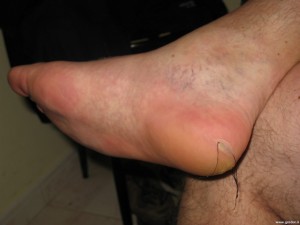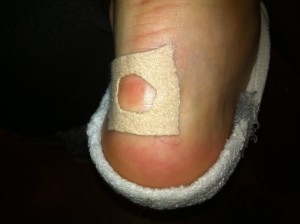If you have to bugout and move for long distances under heavy load, most likely your feet will be the first thing to go. There could be a number of contributing factors to this which include but are not limited to:
– You are wearing new boots, or boots that do not fit well.
– While you enjoy running and exercising, you don’t actually get out to hike much.
– You made a poor sock choice (white gym socks) or are wearing socks you haven’t tried out before.
– Your BOB fits terribly, causing you to walk unnaturally.
– The route you have selected takes you over very uneven terrain.
Whatever the reason may be for developing that nasty little blister on your foot, if you fail to deal with it promptly you will most likely be reduced to a weeping shell of your former self in no time at all. You’ll be limping along with every step being just a little more agonizing than the one before. While you can push through the pain (many cannot) it is advisable to address the situation promptly, as “sucking it up” will only contribute to more damage which will take longer to heal. Obviously the best way to treat a blister is to prevent it from happening altogether. However if you are marching along to your bugout location and discover one of those fluid filled sacs on your foot, here is one way to treat it which I have always found very helpful.
What you will need: Lighter, Sewing needle, Thread, Moleskin, Knife.
1- Thread the sewing needle.
2- Burn needle with the lighter briefly as a field expedient way to sterilize it.
3- Thread the needle through one end of your blister and then out the other side. Leave 1/4 inch or so of the thread hanging out of either side of the blister so that the fluid can drain on it. This is not my foot but I found a picture online of what this should look like once complete. He definitely needs to trim the thread but otherwise it looks good.
4- Use your knife to cut a doughnut shaped hole into a patch of moleskin, the hole should be large enough so that it can fit around your blister.
5- Place the moleskin patch on your foot so that the blister is inside of the doughnut hole. This will provide just enough space between your boot sock and the blister itself to prevent more friction from occurring while you walk. I found another example of this online, notice there is no thread present in this picture.
Once you have taken all of those steps you are complete., put your boots back on and continue walking! The whole process takes less than 5 minutes and can be done on the side of a trail while sitting on the ground. Here are a few additional tips which will help to prevent blisters from occurring, or at least minimize their impact on your ability to move while under the weight of a BOB.
– Make sure your boots are broken in, regardless of whether or not they are military issued boots or $250 whiz bang specials that you bought from the camping store. If you can’t get out on a hiking trail just wear them on the weekends while out in the yard, anything to help break them in. Also make sure your boots fit well.
– Socks! Wear good socks, and by that I don’t mean those 20 year old socks from basic training that feel only slightly more pliable than cardboard. This is one area where you cannot afford to be a cheapskate, good socks are essential. Try out a few different brands in order to see what feels good on your feet.
– Speaking of socks, make sure to change them out while on the move (if possible). If your feet sweat this could help out quite a bit. You will be surprised just how good it feels to change socks during a break before stepping off to walk again.
– Try out your gear. Make sure you BOB fits correctly and that all of that cool guy tactical gear you bought online is configured properly so nothing rubs unnaturally while moving. Anything that pokes against you could cause you to change your gait which could contribute to blisters.
Right now as I sit here typing I am prepared to be fully geared up and out of my home in under 10 minutes. If I had to walk, with a bugout bag and full kit, 15 to 20 miles in order to escape some sort of catastrophe here is the first thought that would come to mind: I hope my feet make it. I wouldn’t be worried about the weight of my rucksack, or if I was physically fit enough to carry it, or if I could move tactically so as to avoid evil doers….no I would be concerned about my feet. You and I must do everything we can to prevent and treat (if necessary) blisters or we might not make it past mile 3 on the way to our BOL.











5 comments
Skip to comment form
I hiked on the Appalachian Trail last June and “walked away” with no blisters. The key is to keep your feet dry. I wear a wool sock with a non-cotton liner. Every couple hours or so, I stopped and put Gold Bond foot powder on and changed my socks for the pair I was air drying on my backpack.
I also carry small alcohol wipes to clean blisters and needles prior to draining the culprit.
Author
Ditch Doctor
Great comment and I would agree. Gold bond foot powder is amazing and works quite well. How far did you go on the AT? One of my goals is to hike the entire thing….
We just hiked for a week in North Carolina and Tennessee, but the plan is to return in June of 2013 and continue north into Virginia. We met a lot of really nice folks on the trail and had a blast. I went with 2 brothers and this year we will add another brother. The key is the right equipment and the proper training.
Take care
I know this article is over a year old, but since I found it, I figured I’d add my comments. As a former field medic, I’ve been using this technique for years. The only thing I wanted to note was that I would strongly advise against using a lighter on the needle, as this creates a potential infection vector via carbon.
If you’re a prepper, of even a casual hiker, you should have a first aid kit. Whether a minimalist kit or a something more advanced, your kit will most likely include alcohol swabs…swab the blister and the area around it, swab your your fingers, then pass the needle AND the thread through the swab to sterilize it.
Author
MadMorb
Thanks for the input. I’ve used the lighter on the needle technique for years, guess I’ve been doing it wrong!